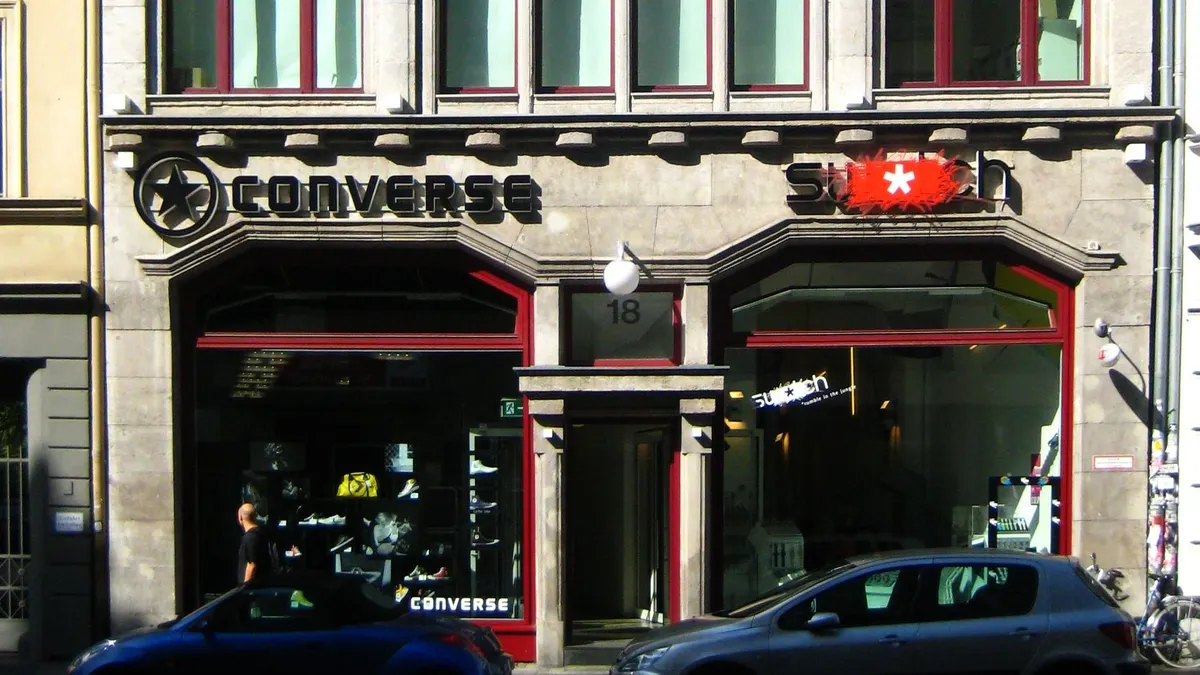We all think of Amazon as a 21st-century retail sensation, but its path to success was bushwhacked years ago by two iconic but very different companies: American retailer Sears, founded in Chicago in 1893, and furniture maker Ikea, launched precisely 50 years later in Sweden by an ambitious 17-year-old schoolboy named Ingvar Kamprad, who christened the fledgling business after a common Scandinavian mash-up of his own name.
Aided by advances in transportation and manufacturing, both Sears and Ikea radically disrupted the retail landscape, introducing key innovations in pricing, merchandising and marketing. But while Sears is now a shadow of its former self, struggling to stay afloat in a web commerce-driven world that would have been a natural fit for its fundamental strengths (don't forget how the Sears catalog revolutionized retail by offering a huge assortment at low prices for delivery to your doorstep), Ikea has only grown in the 31 years since its first U.S. store opened in a Philadelphia-area mall. The company known across the globe for its cheap-chic pressboard furniture now operates some 300 stores in 27 countries, and does some $36 billion in sales each year worldwide.
“[Ikea is] an amazing operation," home furnishings business journalist Warren Shoulberg wrote in The Robin Report last year. “There is perhaps no other retailer on the planet that has moved its basic model into so many places with so much success. That alone would make Ikea a leader in the retailing business. [But] Ikea’s influence is really about its merchandising model, products, pricing, store siting, marketing, sourcing and even its convoluted name. And that’s not even talking about the meatballs” (the signature menu item in its in-store food concessions arsenal).
But Ikea is at a crossroad. Admittedly late to e-commerce and increasingly hamstrung by its reputation for inexpensive, lower-quality (if well-designed) merchandise, the company says that it’s taking steps to elevate its standards.
“Customers expect us to do more,” Ikea CEO Peter Agnefjall told Reuters last month. “And nowadays you can't really make products that are throwaway: When you buy a sofa table, it needs to be built to last.”
But experts say that reassembling Ikea's image will be a challenge, because pivoting away from its core product ethos could also require the retailer to abandon its signature low prices. Right now, it’s a confusing proposal, says Jeff Green, president of retail consultancy Jeff Green Partners.
“What we really don’t know is how is the merchandise mix—as it relates to quality—going to change?” Green told Retail Dive. “Can [Ikea] upscale their merchandise to something that denotes higher quality? It would be understandable if they’re trying to follow their existing customer as they age, but they’ve got to do that without turning off their existing customers, who have always had very high loyalty. What I also don’t understand is whether this something that is indicative of only their U.S. stores, because in Sweden and Scandinavia, people may not have the same issues with their quality. So is this an American thing, or is this a worldwide, chain-wide thing?”
The quality quandary
Turning around Ikea’s reputation for low-quality, difficult-to-assemble furniture could be quite an uphill climb. While its functional, minimalist aesthetic is appealing to many people (including, in the past couple of decades, Americans taught by Target that “chic” can be cheap), the poor production values of most Ikea furniture and home goods keep them reserved for extremely budget-minded consumers like college students or young professionals outfitting their first apartment, says Philip Ryan, associate partner at consulting firm Vivaldi.
“They have so much brand equity, but it’s not very high quality,” Ryan told Retail Dive. “It’s great design, very functional. It’s almost akin to Zara [fast-fashion] clothing.”
Even Ikea’s biggest fans will tell you its stuff isn’t exactly built to last. In some cases, it’s not even built to stand, at least not without special tools to fasten it to a wall. Longevity is far from the only concern. Agnefjall's call to manufacture higher-quality goods arrived soon after Ikea recalled 29 million chests and dressers sold in North America and China—products blamed in multiple deaths and injuries of young children.
But Sam Sohali, founder and executive creative director of marketing and advertising agency DMA United, says those tragedies are just one factor driving Ikea’s evolving manufacturing philosophies.
“I think it has to be both safety and quality, only because I don’t think a company would make these kinds of changes purely because a dresser tipped over,” Sohali told Retail Dive. “Let’s say they make that [recalled] ‘Malm' dress safer—the consumer walking in is not going to say ‘Wow, that’s amazing.’”
Transforming Ikea will take more than upgrading the materials and fabrics its merchandise is made of, however. It must also include changes to marketing and improvements to stores, Ryan says.
“I was in an Ikea just a few months ago, and even some of the furniture that was out on the floor looked worn and torn and damaged,” Ryan noted. “There are all kinds of factors that go into a premium line. It’s not just the products themselves. It’s also interactions with the customers.”
More than one expert consulted by Retail Dive noted that even Ikea’s notoriously confounding assembly instructions may have to change. The difficulty of putting together a piece of Ikea furniture is almost a part of the brand experience, to the point that it was recently lampooned in the hit movie "Deadpool." (Ikea, by the way, didn’t pay for the backhanded-compliment product placement, but, demonstrating a sense of humor, insisted the scriptwriters employ the actual Swedish names of its furniture rather than make up new ones.)
Some Ikea customers don't even try to assemble their purchases, for that matter. For them, on-demand freelance labor TaskRabbit has a page dedicated to its services putting together Ikea furniture.
But the overwhelming frustration that comes from spending a day puzzling over new Ikea pieces would be unacceptable to a customer purchasing higher-end furniture, says Ryan, adding that competitors are pointedly providing less inscrutable directions to differentiate their customer experience.
“The way you put [Ikea] furniture together—it’s almost impenetrable, while [online furniture retailer] Wayfair is very focused on making sure that its instructions are very simple when it comes to what goes where," Ryan said. “The interactions are very simple and easy for their customer.”
Forging a path to growth
Given the complexities facing Ikea's reinvention dreams, it's natural to question why the company is tackling the challenge. Ikea did not respond to requests from Retail Dive to expound on its plans, but experts say its desire to evolve its customer base comes from an appetite for growth—a natural impulse for any retailer.
“Basically, every company is looking for growth,” DMA United's Sohali said. “X number of consumers have awareness of my brand, but where do I grow from here?”
That hasn’t come from digital sales, at least so far. Ikea for years largely eschewed e-commerce, conducting the vast majority of its business through its big-box stores and print catalog. The strategy has slowed the retailer’s overall growth, and after reporting overall online sales growth of just 0.4% in 2014, Ikea pledged to increase e-commerce from about €1 billion per year to at least €5 billion in the next five years, in order to meet its targeted sustained overall growth rate of 10% per year.
Agnefjall has attempted to spin Ikea's slow migration to digital into a positive, saying last year that its late entry into online commerce could allow more nimble mobile capability from the outset. "We could have been faster, I could agree to that," Agnefjäll told CNBC in October. "But by being late we can skip a step in the technology development, straight to mobile and tablet.”
But while those flat packs of DIY-assembled furniture are designed to fit into customers' cars (an idea that came from an Ikea worker taking the legs of a table to get it to fit, according to company lore), they’re also heavy and expensive to ship. That means that boosting e-commerce, which eats into the margins of most retailers, could take away even as it gives.
“This is an area where shipping fees can really take a toll because you’re moving furniture,” Jaimee Minney, VP of marketing and public relations at Slice Intelligence, told Retail Dive. “The big challenge, unique to e-commerce, is how best to maximize the shipping and handling aspect. When you have gigantic stores you don’t have to think about it as much.”
Expanding its customer base by selling products that are accessible to college students and that remain appealing into their home-buying years would be a more effective growth strategy across all channels, experts say. Still, while Ikea stores have done a good job of providing a destination-like customer experience even with their warehouse-like big-box approach, that’s still not enough, according to Sohali.
“I think that Ikea is an experience. The restaurants—every child wants the meatballs,” he said. “But it’s time to give the customer a surprise. Maybe a high-end designer does a special line for them, or certain tables made of teak, or sofas with nappa leathers—anything that would make my antenna go up.”
But Ikea seems lukewarm about working with outside designers... or at least Kanye West. Speaking to BBC Radio earlier this month, the hip-hop artist and fashion designer expressed a desire to design for Ikea that has grown since his March visit to the company’s Swedish offices. "'Yo Ikea, allow Kanye to create, allow him to make this thing because you know what, I want a bed that he makes, I want a chair that he makes,'" West said, impersonating a Ikea-buying college student. He then said, representing himself, “I have to work with Ikea, make furniture for interior design, for architecture.”
An Ikea spokesperson would only tell Quartz, “We are really flattered for the attention around the visit, and also in Kanye West’s high interest in Ikea. There have been many speculations around potential plans for future collaborations, but we can confirm that we have no collaboration at this moment.”
But no matter what, Ikea must think differently and take radical steps if it truly hopes to move on up. Sohali recommends a higher-quality sub-brand that expands its innovations beyond design and materials to include carefully curatex store-within-store areas with a more upscale feel.
“Quality alone doesn’t give you that growth—that’s why the idea of creating a sub-brand would be very beneficial to them,” Sohali said. “It may not even be a money maker, but it does make a new consumer segment—maybe the customer that would find stuff they like at Crate and Barrel—look at them. That’s a natural progression for the brand.”
That progression to better quality is not unprecedented, Vivaldi Partners' Ryan notes. From the 1970s to the 1990s, for example, Japanese electronics makers managed to flip their reputation for poor design and acoustics to international renown for top-notch quality. More recently, Korean auto-makers have made a similar turnaround, Ryan adds.
But it's not simply a question of whether Ikea can make good on its upmarket ambitions, Ryan says. He believes the company must make changes... or else suffer the conquences.
“I don’t think they can survive without increasing quality,” Ryan said. “We see quality being asked for more and more, [with] fewer throw-away products and more ‘considered consumption.’ You need products that you know are going to last. It started in the ultra-luxury space, and it’s why Louis Vuitton is going back to master craftsmanship. Ikea needs to do that just to maintain their market share, even at that lower end.”



















